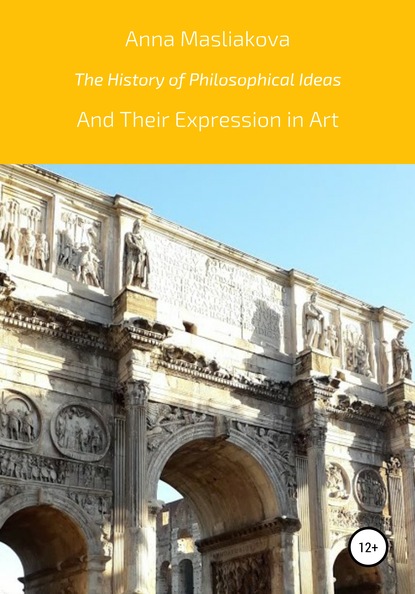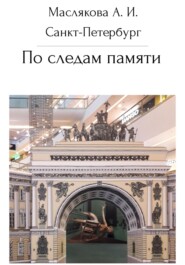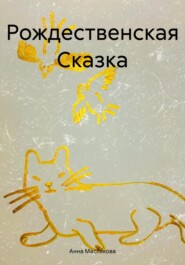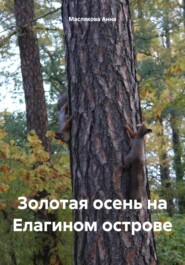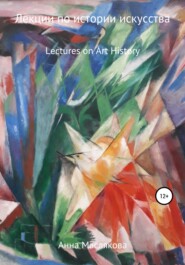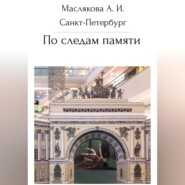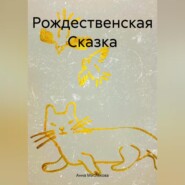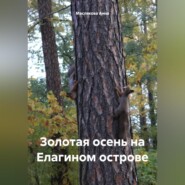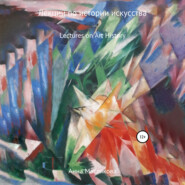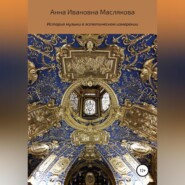По всем вопросам обращайтесь на: info@litportal.ru
(©) 2003-2024.
✖
The History of Philosophical Ideas and Their Expression in Art
Автор
Год написания книги
2020
Настройки чтения
Размер шрифта
Высота строк
Поля
The History of Philosophical Ideas and Their Expression in Art
Анна Ивановна Маслякова
It seems to me that there is something Mysterious about Art. The History of Art is closely connected with Philosophical Ideas of the time. In this book we are going to scrutinize the way in which Philosophical Ideas have been expressed in Art from Antiquity to the Present Day. We are going to visit a lot of cities – Rome, Florence, Munich, Barcelona, Berlin, Riga, Tallin, Prague, Helsinki, Stokholm, Saint Petersburg… That is to say, we are going to Travel throughout the Whole History of Humanity and I hope that at the end of our Journey we will know more not only about Art, but also about ourselves.
To my dear parents
“Nel mezzo del cammin di nostra vita
mi ritrovai per una selva oscura
che’ la diritta via era smarrita”
(Dante. “La Divina Commedia”). [1 - “Midway upon the journey of our life / I found myself within a forest dark, / for the straightforward pathway had been lost” (Dante. “Divine Comedy”).]
“Puesto nombre, y tan a su gusto, a su caballo, quiso ponеrsele a s? mismo, y en este pensamiento durо otros ocho d?as, y al cabo se vino a llamar “don Quijote”; de donde, como queda dicho, tomaron ocasiоn los autores desta tan verdadera historia que, sin duda, se deb?a de llamar “Quijada”, y no “Quesada”, como otros quisieron decir”. (Miguel de Cervantes. “El ingenioso hidalgo don Quijote de la Mancha”).[2 - “Having got a name for his horse so much to his taste, he was anxious to get one for himself, and he was eight days more pondering over this point, till at last he made up his mind to call himself “Don Quixote,” whence, as has been already said, the authors of this veracious history have inferred that his name must have been beyond a doubt “Quixada”, and not “Quesada” as others would have it” (Miguel de Cervantes. “The History of Don Quixote”).]
‘“Must I show you a place to sleep? Are you not at home here?”. “I understand that you take me for one of the tiny folk,” said the midget, “but I’m a human being, like yourself, although I have been transformed by an elf.” “That is the most remarkable thing I have ever heard! Wouldn’t you like to tell me how you happened to get into such a plight?” The boy did not mind telling her of his adventures, and, as the narrative proceeded, she who listened to him grew more and more astonished and happy. “What luck to run across one who has travelled all over Sweden on the back of a goose!” thought she. “Just this which he is relating I shall write down in my book. Now I need worry no more over that matter. It was well that I came home. To think that I should find such help as soon as I came to the old place!” Instantly another thought flashed into her mind. She had sent word to her father by the doves that she longed for home, and almost immediately she had received help in the matter she had pondered so long. Might not this be the father’s answer to her prayer?”’. (Selma Lagerl?f. “The Wonderful Adventures of Nils”).
Introduction
It is generally accepted that there are Turning Points in our lives that Change Us Forever. So, let me tell you My Story.
I remember my mother sitting at the piano and playing the “Swan Lake”. It was then that I decided to become a Musician. I had no fear of performing in front of the audience and I could play the piano without even looking at the keyboard.
When I was studying at the Music College in Smolensk, fate, once again, intervened on my behalf – one of the professors recommended me to read a book about Alexander Scriabin. And from that time on, the creativity of this composer has captured my imagination.
In Minsk I have met with Elena Polyakova – my Master’s supervisor who has eventually become my best friend ever. She taught me how to write articles and we used to talk a lot about Art and Education.
We attended conferences in Vitebsk, Mogilev, Moscow and, finally, we visited Saint Petersburg where I have made an acquaintance with another professor – Alexander Klujev – who has also played a significant part in my scientific career. He has never interfered with my PhD research, on the contrary, he encouraged me to develop my own creativity.
And last but not least, I strongly believe that it is absolutely impossible to study Art without Travelling. You can read a lot about the Sistine Chapel or the Sainte-Chapelle, and yet, not until you see them will you realize the real Power of Art. Among the masterpieces that have impressed me most are Claud Monet’s “Waterloo Bridge”, D?rer’s “Self Portrait”, Raphael’s Lodges, Van Gogh’s “Sunflowers”, the Gates of Paradise by Lorenzo Ghiberti, etc. That is why my research is complemented by the so-called “Impressions of the Cities”. Although all the Chapters of the Book are in Chronological Order, each of them has its own Form and I encourage you to Choose the Sequence of the Chapters according to your personal preferences. Taking into account the fact that the Beauty of the World is Endless, this research will be continued.
The Healing Power of Art
It seems to me that there is something Mysterious about Art. On the one hand, you could be a spectator and go to Concert Halls, Theaters and Museums and, as for me, I could spend hours walking around exhibitions, looking at Paintings and Sculptures and contemplating the Power of Art. I am virtually certain that nothing could be better than Live Concerts, especially when an Author is sitting in the audience, since when the curtain opens and conductor goes on stage, Magic happens and you feel a sense of Unity not only with humanity, but also with the whole Universe.
On the other hand, you could take Your Story and Paint it, Sing it, Dance it or Write about it and thus enhance the Healing Power of Art. Since you have everything you need inside you, you should Open up your Heart, Honor the Light inside you and Bring the Gifts of Your Creativity to the World. One should not forget that There Can Be No Mistakes in Art, that is to say, you should Release the Inner Critic within you and Be Who You Are. And I must say that for me it has been one of the most challenging problems because I have been suffering from self-doubt all my life.
I am virtually certain that Eastern Culture and Philosophy may be helpful. According to “Dao De Jing”, sometimes when you want something to happen you have to do the opposite. “Dao ever-constantly practices non-action, / Yet nothing is left undone. / If nobles and kings could maintain it, / The ten thousand creatures would naturally transform. / Transform, and if desire arises, / I would restrain it by means of the nameless uncarved block. / In the state of the nameless uncarved block, / Men also would be without-desire. / Not desiring, thus they would be still – / And the world would naturally settle”. And Basho’s Haiku Poems which often have multiple meanings are fascinating – “Temple bells die out. / The fragrant blossoms remain. / A perfect evening!”. I absolutely adore the Mysterious sound of Guzheng – a very old Chinese plucked string instrument tuned in a major pentatonic scale. There are the so-called Talking Drums and by changing the pitch of the drum you can imitate African speech patterns and send Musical Messages over long distances. Singing Bowls, on the other hand, are widely used in Buddhist Temples or Pagodas since not only can you produce a tone by striking the edge of the bowl, but you can also create residual vibrations which have Healing properties. In India they know how to lead a happier life as well, suffice it to mention Holi – an ancient festival during which people laugh, dance and spray bright colors on each other. Their Temples look Magnificent (for example, the Lakshmana Temple) and nothing can be compared with Indian Music which is not fixed and stable but, on the contrary, relies on improvisation and is characterized by sliding or gliding from one Svara (tone) to the next (“Sarasiruha” – “To the Goddess Saraswati” starting from the free-flowing exploration of the Raga – an Indian equivalent of Scale). And despite the fact that Indonesian Music, the entire system of which is based on a sense of pitch that is outside our twelve tone realm, may sound strange, it has its own Beauty.
As a matter of fact, I have always tried to create “Sacred Spaces” – artistic compositions consisting of porcelain statuettes, postcards, toys, artificial flowers – and put them all over my flat so as to feel comfortable and safe. But when the virus started spreading around the world and they told us to stay at home, I became afraid and could do nothing. Then I decided to finish my Book on Art and when I was writing about my previous trips around Europe, I felt as if I was visiting those places once again. Or, even more, as if I had never left them. And after a while my mother asked me to create some illustrations for her new book. I hesitated at first since I am a Musician and not a Painter. And yet, it was so exciting that I ended up writing Poetry so as to make it easier for children to learn Musical Language. It was fun and these “jobs” helped me to overcome stress. Interestingly enough, I did not use dark colors in my paintings, on the contrary, I chose yellow, blue, red, green and pink.
Suddenly I realized that My Mission in life is to Explore the Beauty of the World and Share my Knowledge with People. I do believe that Art as a whole and This Very Book in particular could help you to overcome pain and darkness and Transform your Soul. All in all, Life is nothing but a Dream and like Zhuangzi who “didn’t know if he was Zhuangzi who had dreamt he was a butterfly, or a butterfly dreaming he was Zhuangzi” you might never find final solution to this problem.
The Big History of Art
I have been studying the connection between different branches of Art for a long time and was delighted to know that there is a significant basis for my research. That is to say, the carbon, nitrogen and oxygen atoms in our bodies, as well as atoms of all other heavy elements, were created in previous generations of stars over 4.5 billion years ago. This idea that We are all Made of the Same Staff as Stars took me by surprise. So, we all have the same birthday – the Beginning of the Universe.
Interestingly enough, the Earth is a Closed System and it must obey the Second Law of Thermodynamics according to which the Universe has a consistent amount of energy, and when some energy is lost in any operation, it ultimately leads to the Rise of Entropy and the inevitable Heat Death of Matter in the Universe. It implies that the Universe is destined to get simpler and simpler, even though its “pockets” still enjoy concentrations of energy, energy flow, and therefore complexity. On the other hand, there are a lot of Open Systems on Earth to which this Law cannot be applied and Art, being one of them, interacts with the environment and conveys Great Ideas of Humanity in Sound, Color, Shape, etc. Different branches of Art (Music, Painting, Sculpture, Architecture, etc.) are in constant Dialog with each other and, from time to time, they Unite their forces (Opera, Ballet, Happening, Installation, etc.) so as to make it easier for us to appreciate the Beauty of the World. And yet, we may never understand what is a Piece of Art-in-itself since all we know is the way in which Art appears For-Us in different interpretations.
According to the Big History Project, there are Eight Main Thresholds – major phase-shifts leading to the beginning of the Universe, the First Stars, new Chemical Elements, the origin of Planets and the Solar System, the Beginning of Life, the Evolution of Collective Learning, the Emergence of Agriculture, and the Beginning of the Modern Revolution. In this book we are going to scrutinize the way in which Philosophical Ideas have been expressed in Art from Antiquity to the Present Day. If the predictions are true and life on Earth will be destroyed, all we can do is try to postpone this event by developing new technologies enabling us to travel through the Universe and find another planet on which we could live and Create New Art.
Musical and Aesthetic Concept of Alexander Scriabin
Many years ago one of my College Professors recommended me to read a book about Alexander Scriabin. And from that time on, Scriabin’s creativity has captured my imagination. It goes without saying that Alexander Scriabin is one of the most Mysterious Figures of the 20
century. Not only did he compose Music, but he also wanted to Transform the World by using the Power of Art. In other words, he believed that the Performance of his “Mysterium” comprised of different branches of Art could cause Dematerialization and Rebirth of Humanity.
Alexander Scriabin was an extremely versatile person and his Literary and Philosophical works correspond to his Music. The Early period of his creativity (up to 1900) has very much in common with Romantic tradition and then (from 1900 till 1910) the Center of his Aesthetic interests starts shifting towards the Personality of the Artist who is able to Bring Beauty to the World. This “reorientation” triggered radical changes in his Musical Style, namely Functional Inversion, the Emancipation of the Dissonance and the Compression of the Form. During the Late period of his creativity (from 1910 till 1915) Scriabin was fully occupied with the Realization of his Project and most of his last works could be viewed as “splinters” of the Ideal Piece of Art – the “Mysterium”. “Prometheus: The Poem of Fire” is a fine example of the expression of the Idea of the Total Unity since here Music is complemented by the Color Organ Part (Luce) whereas Melody is derived from Harmony and vice versa (“Prometheus Chord”). Interestingly enough, during the last years of his life his Musical Language was changing towards Simplicity and it seems to me that the so-called “Style of Black Line on White Background” (Prelude op. 74 No. 2) fully expresses Scriabin’s Passion for Unity and Beauty.
In this Book the idea of which appeared when I was writing my previous monograph on the creativity of Alexander Scriabin I am going to scrutinize the way in which different Philosophical Ideas have been conveyed in Art. That is to say, we are going to Travel throughout the Whole History of Humanity and I hope that at the end of our Journey we will know more not only about Art, but also about ourselves.
There is No Place Like Rome
As a matter of fact, I have always wanted to travel around the world, explore cultural diversity. In particular, I have read a lot about Wonders of Italy; hence, it is no surprise that my first destination was Rome. Actually, it was my mother who forced me to go there, metaphorically speaking. So, there I was, flying to Italy on my own. The truth is that, being proud of myself, at the same time I was trembling and thinking – Is it worth it?
Little did I know what would come next.
Firstly and most importantly, you could talk endlessly about the charm of Rome as many prominent scientists and artists have done before. And yet, only when you arrive there will you realize what is this all about. On the one hand, Rome is without any doubt the Spiritual Center of the Christian World. It seems to me that even the sun shines more brightly there than anywhere else. On the other hand, Rome has some dark pages in its divine history. It is hard to believe, but before Constantine the Great made the Roman Empire Christian in 313 A.D. Christians were arrested and tortured at the Colosseum.
Secondly, it is extraordinary that, despite all the obstacles, they did manage to preserve the achievements of the past till the present day. Rome is like a multi-storey building and it has its foundation – Antiquity. What I am trying to say is that the Whole History of Art lies in front of you, right under your feet – literally speaking. All you need to do is walk along the curvy streets of the city and look around.
Last but not least, the influence of the Roman Culture has been so huge that one can find a lot of replicas of Italian Architecture in many other countries. I presume, there are two main ways of studying the History of Art. The first one is the shortest and the hardest – you may start from the beginning and go to Rome. Or you could travel around Europe trying to put the puzzle – “pieces of Rome” – together.
To sum it up, it was love from the first sight. I will never forget the ringing of the bells of Santa Maria Maggiore at 9 P.M. If you ask me, I am virtually certain that this Mysterious Sound really is the Essence of the Roman Spirit.
Chapter I
Literary Essay I
It is undeniable that Ancient Philosophy has had a tremendous impact on Western Culture. Since Socrates, Plato and Aristotle lived before Christianity and could not enter Paradise, Dante had nothing to do but put them in Limbo, which is the first circle of Inferno in “The Divine Comedy”. And even there they were having a perpetual seminar and discussing their works with each other.
Some may argue that Ancient Philosophers were not always right (for example, Ptolemy’s Geocentric model of the Universe has become obsolete), but the fact that they were trying to find out the First Principle of All Things – or Arche – is awesome.
It is no wonder that artists tend to insert “quotations” from Ancient sources in their paintings. Let us have a look, for example, at “The Spinners” by Diego Velаzquez where he combines two subjects – one from Classical Mythology and the other from the era in which he lives. That is to say, in the background we can see Jupiter’s Rape of Europa waved by Arachne who was turned into a spider by Minerva since she could not find any flaws in Arachne’s carpet. While in the foreground there are real women from Velаzquez’s time involved in tapestry manufacturing.
There is the Crown Fountain in the Summer Gardens in Saint Petersburg surrounded by busts of Ancient Philosophers – Diogenes, Heraclitus, Democritus, Aristotle, etc. So that people wandering around in search for some shade could stop for a moment and admire their dedication and commitment in the pursuit of knowledge. Surprisingly enough, Ancient method of “thinking while walking” has not lost its effectiveness nowadays. I practice it all the time especially when writing an article or a book since it helps me to concentrate and organize my thoughts.
In the famous “Allegory of the Cave” Socrates tells us about prisoners who live under the earth and can see nothing but shadows projected on the wall from objects being carried along in front of a fire. What I am trying to say is that in order to gain freedom we need to break the chains and walk towards the Light. It may hurt our eyes at first, but we will get used to it in the end.
Philosophical Issues I
Pre-Socratic philosophers were asking questions about the nature of things. And their answers were really amazing, for example, the qualitative monism of the Milesians who believed that everything could be reduced to, derived from one or several elements (water – Thales; air – Anaximenes; fire – Heraclitus; water, air, fire, earth – Anaximander, etc.). According to the double-aspect theory of Pythagoras and Heraclitus, everything is in the process of change and, at the same time, everything is in order which, by the way, could be of different kinds – mathematical order (Pythagoras) or Logos (Heraclitus). Moreover, there was the absolute monism of the Eleatics, the pluralism of Democritus (Mechanism) and Anaxagoras (Teleology), etc. In other words, Pre-Socratics were formulating the philosophical agenda that Western Philosophy has worked with ever since.
While the Sophists were skeptical of the possibility of knowing the truth about reality and turned from the pursuit of knowledge to the practice of Rhetoric trying to persuade people by non-logical means, Socrates, on the contrary, was interested in the cultivation of souls and developed his own method of achieving this result which was called Dialectic. The way in which Dialectic uncovers the truth is very much like the way in which we recollect something. And the object of knowledge is not the world of Particulars (the world of time and change), but rather the reality of Forms, the first patterns that everything else follows.
In “The Symposium” Plato suggests that since Forms are universal an unchangeable and Particulars are always changing and temporal, we should distinguish between the essence of the Ideal Beauty which could be grasped only “with the eye of the mind” and particular beautiful things. We should “begin from the beauties of earth and mount upwards for the sake of that other beauty, using these as steps only, and from one going on to two, and from two to all fair forms, and from fair forms to fair practices, and from fair practices to fair notions, until from fair notions he arrives at the notion of absolute beauty, and at last knows what the essence of beauty is”.
Earthly life ought to be harmoniously ordered and unified following the example of the Cosmos, including a human individual who is a microcosm, a part of the whole. Society should encourage the development of the capacity of mind to love and know the ideal order, especially when the training of heroes is concerned. Socrates asks in “The Republic” – “And what shall be their education? Can we find a better than the traditional sort? – and this has two divisions, gymnastic for the body, and music for the soul. True. Shall we begin education with music, and go on to gymnastic afterwards? By all means”. Besides, Plato writes that “musical training is a more potent instrument than any other, because rhythm and harmony find their way into the inward places of the soul, on which they mightily fasten, imparting grace, and making the soul of him who is rightly educated graceful, or of him who is ill-educated ungraceful; and also because he who has received this true education of the inner being will most shrewdly perceive omissions or faults in art and nature, and with a true taste, while he praises and rejoices over and receives into his soul the good, and becomes noble and good, he will justly blame and hate the bad, now in the days of his youth, even before he is able to know the reason why; and when reason comes he will recognize and salute the friend with whom his education has made him long familiar”. And yet, adding that “the musician is wise, and he who is not a musician is foolish”, he excludes harmonies expressive of sorrow (Lydian), softness and indolence (Ionian) from the educational process and advises to use Dorian and Phrygian harmonies since they stimulate courage and temperance.
Анна Ивановна Маслякова
It seems to me that there is something Mysterious about Art. The History of Art is closely connected with Philosophical Ideas of the time. In this book we are going to scrutinize the way in which Philosophical Ideas have been expressed in Art from Antiquity to the Present Day. We are going to visit a lot of cities – Rome, Florence, Munich, Barcelona, Berlin, Riga, Tallin, Prague, Helsinki, Stokholm, Saint Petersburg… That is to say, we are going to Travel throughout the Whole History of Humanity and I hope that at the end of our Journey we will know more not only about Art, but also about ourselves.
To my dear parents
“Nel mezzo del cammin di nostra vita
mi ritrovai per una selva oscura
che’ la diritta via era smarrita”
(Dante. “La Divina Commedia”). [1 - “Midway upon the journey of our life / I found myself within a forest dark, / for the straightforward pathway had been lost” (Dante. “Divine Comedy”).]
“Puesto nombre, y tan a su gusto, a su caballo, quiso ponеrsele a s? mismo, y en este pensamiento durо otros ocho d?as, y al cabo se vino a llamar “don Quijote”; de donde, como queda dicho, tomaron ocasiоn los autores desta tan verdadera historia que, sin duda, se deb?a de llamar “Quijada”, y no “Quesada”, como otros quisieron decir”. (Miguel de Cervantes. “El ingenioso hidalgo don Quijote de la Mancha”).[2 - “Having got a name for his horse so much to his taste, he was anxious to get one for himself, and he was eight days more pondering over this point, till at last he made up his mind to call himself “Don Quixote,” whence, as has been already said, the authors of this veracious history have inferred that his name must have been beyond a doubt “Quixada”, and not “Quesada” as others would have it” (Miguel de Cervantes. “The History of Don Quixote”).]
‘“Must I show you a place to sleep? Are you not at home here?”. “I understand that you take me for one of the tiny folk,” said the midget, “but I’m a human being, like yourself, although I have been transformed by an elf.” “That is the most remarkable thing I have ever heard! Wouldn’t you like to tell me how you happened to get into such a plight?” The boy did not mind telling her of his adventures, and, as the narrative proceeded, she who listened to him grew more and more astonished and happy. “What luck to run across one who has travelled all over Sweden on the back of a goose!” thought she. “Just this which he is relating I shall write down in my book. Now I need worry no more over that matter. It was well that I came home. To think that I should find such help as soon as I came to the old place!” Instantly another thought flashed into her mind. She had sent word to her father by the doves that she longed for home, and almost immediately she had received help in the matter she had pondered so long. Might not this be the father’s answer to her prayer?”’. (Selma Lagerl?f. “The Wonderful Adventures of Nils”).
Introduction
It is generally accepted that there are Turning Points in our lives that Change Us Forever. So, let me tell you My Story.
I remember my mother sitting at the piano and playing the “Swan Lake”. It was then that I decided to become a Musician. I had no fear of performing in front of the audience and I could play the piano without even looking at the keyboard.
When I was studying at the Music College in Smolensk, fate, once again, intervened on my behalf – one of the professors recommended me to read a book about Alexander Scriabin. And from that time on, the creativity of this composer has captured my imagination.
In Minsk I have met with Elena Polyakova – my Master’s supervisor who has eventually become my best friend ever. She taught me how to write articles and we used to talk a lot about Art and Education.
We attended conferences in Vitebsk, Mogilev, Moscow and, finally, we visited Saint Petersburg where I have made an acquaintance with another professor – Alexander Klujev – who has also played a significant part in my scientific career. He has never interfered with my PhD research, on the contrary, he encouraged me to develop my own creativity.
And last but not least, I strongly believe that it is absolutely impossible to study Art without Travelling. You can read a lot about the Sistine Chapel or the Sainte-Chapelle, and yet, not until you see them will you realize the real Power of Art. Among the masterpieces that have impressed me most are Claud Monet’s “Waterloo Bridge”, D?rer’s “Self Portrait”, Raphael’s Lodges, Van Gogh’s “Sunflowers”, the Gates of Paradise by Lorenzo Ghiberti, etc. That is why my research is complemented by the so-called “Impressions of the Cities”. Although all the Chapters of the Book are in Chronological Order, each of them has its own Form and I encourage you to Choose the Sequence of the Chapters according to your personal preferences. Taking into account the fact that the Beauty of the World is Endless, this research will be continued.
The Healing Power of Art
It seems to me that there is something Mysterious about Art. On the one hand, you could be a spectator and go to Concert Halls, Theaters and Museums and, as for me, I could spend hours walking around exhibitions, looking at Paintings and Sculptures and contemplating the Power of Art. I am virtually certain that nothing could be better than Live Concerts, especially when an Author is sitting in the audience, since when the curtain opens and conductor goes on stage, Magic happens and you feel a sense of Unity not only with humanity, but also with the whole Universe.
On the other hand, you could take Your Story and Paint it, Sing it, Dance it or Write about it and thus enhance the Healing Power of Art. Since you have everything you need inside you, you should Open up your Heart, Honor the Light inside you and Bring the Gifts of Your Creativity to the World. One should not forget that There Can Be No Mistakes in Art, that is to say, you should Release the Inner Critic within you and Be Who You Are. And I must say that for me it has been one of the most challenging problems because I have been suffering from self-doubt all my life.
I am virtually certain that Eastern Culture and Philosophy may be helpful. According to “Dao De Jing”, sometimes when you want something to happen you have to do the opposite. “Dao ever-constantly practices non-action, / Yet nothing is left undone. / If nobles and kings could maintain it, / The ten thousand creatures would naturally transform. / Transform, and if desire arises, / I would restrain it by means of the nameless uncarved block. / In the state of the nameless uncarved block, / Men also would be without-desire. / Not desiring, thus they would be still – / And the world would naturally settle”. And Basho’s Haiku Poems which often have multiple meanings are fascinating – “Temple bells die out. / The fragrant blossoms remain. / A perfect evening!”. I absolutely adore the Mysterious sound of Guzheng – a very old Chinese plucked string instrument tuned in a major pentatonic scale. There are the so-called Talking Drums and by changing the pitch of the drum you can imitate African speech patterns and send Musical Messages over long distances. Singing Bowls, on the other hand, are widely used in Buddhist Temples or Pagodas since not only can you produce a tone by striking the edge of the bowl, but you can also create residual vibrations which have Healing properties. In India they know how to lead a happier life as well, suffice it to mention Holi – an ancient festival during which people laugh, dance and spray bright colors on each other. Their Temples look Magnificent (for example, the Lakshmana Temple) and nothing can be compared with Indian Music which is not fixed and stable but, on the contrary, relies on improvisation and is characterized by sliding or gliding from one Svara (tone) to the next (“Sarasiruha” – “To the Goddess Saraswati” starting from the free-flowing exploration of the Raga – an Indian equivalent of Scale). And despite the fact that Indonesian Music, the entire system of which is based on a sense of pitch that is outside our twelve tone realm, may sound strange, it has its own Beauty.
As a matter of fact, I have always tried to create “Sacred Spaces” – artistic compositions consisting of porcelain statuettes, postcards, toys, artificial flowers – and put them all over my flat so as to feel comfortable and safe. But when the virus started spreading around the world and they told us to stay at home, I became afraid and could do nothing. Then I decided to finish my Book on Art and when I was writing about my previous trips around Europe, I felt as if I was visiting those places once again. Or, even more, as if I had never left them. And after a while my mother asked me to create some illustrations for her new book. I hesitated at first since I am a Musician and not a Painter. And yet, it was so exciting that I ended up writing Poetry so as to make it easier for children to learn Musical Language. It was fun and these “jobs” helped me to overcome stress. Interestingly enough, I did not use dark colors in my paintings, on the contrary, I chose yellow, blue, red, green and pink.
Suddenly I realized that My Mission in life is to Explore the Beauty of the World and Share my Knowledge with People. I do believe that Art as a whole and This Very Book in particular could help you to overcome pain and darkness and Transform your Soul. All in all, Life is nothing but a Dream and like Zhuangzi who “didn’t know if he was Zhuangzi who had dreamt he was a butterfly, or a butterfly dreaming he was Zhuangzi” you might never find final solution to this problem.
The Big History of Art
I have been studying the connection between different branches of Art for a long time and was delighted to know that there is a significant basis for my research. That is to say, the carbon, nitrogen and oxygen atoms in our bodies, as well as atoms of all other heavy elements, were created in previous generations of stars over 4.5 billion years ago. This idea that We are all Made of the Same Staff as Stars took me by surprise. So, we all have the same birthday – the Beginning of the Universe.
Interestingly enough, the Earth is a Closed System and it must obey the Second Law of Thermodynamics according to which the Universe has a consistent amount of energy, and when some energy is lost in any operation, it ultimately leads to the Rise of Entropy and the inevitable Heat Death of Matter in the Universe. It implies that the Universe is destined to get simpler and simpler, even though its “pockets” still enjoy concentrations of energy, energy flow, and therefore complexity. On the other hand, there are a lot of Open Systems on Earth to which this Law cannot be applied and Art, being one of them, interacts with the environment and conveys Great Ideas of Humanity in Sound, Color, Shape, etc. Different branches of Art (Music, Painting, Sculpture, Architecture, etc.) are in constant Dialog with each other and, from time to time, they Unite their forces (Opera, Ballet, Happening, Installation, etc.) so as to make it easier for us to appreciate the Beauty of the World. And yet, we may never understand what is a Piece of Art-in-itself since all we know is the way in which Art appears For-Us in different interpretations.
According to the Big History Project, there are Eight Main Thresholds – major phase-shifts leading to the beginning of the Universe, the First Stars, new Chemical Elements, the origin of Planets and the Solar System, the Beginning of Life, the Evolution of Collective Learning, the Emergence of Agriculture, and the Beginning of the Modern Revolution. In this book we are going to scrutinize the way in which Philosophical Ideas have been expressed in Art from Antiquity to the Present Day. If the predictions are true and life on Earth will be destroyed, all we can do is try to postpone this event by developing new technologies enabling us to travel through the Universe and find another planet on which we could live and Create New Art.
Musical and Aesthetic Concept of Alexander Scriabin
Many years ago one of my College Professors recommended me to read a book about Alexander Scriabin. And from that time on, Scriabin’s creativity has captured my imagination. It goes without saying that Alexander Scriabin is one of the most Mysterious Figures of the 20
century. Not only did he compose Music, but he also wanted to Transform the World by using the Power of Art. In other words, he believed that the Performance of his “Mysterium” comprised of different branches of Art could cause Dematerialization and Rebirth of Humanity.
Alexander Scriabin was an extremely versatile person and his Literary and Philosophical works correspond to his Music. The Early period of his creativity (up to 1900) has very much in common with Romantic tradition and then (from 1900 till 1910) the Center of his Aesthetic interests starts shifting towards the Personality of the Artist who is able to Bring Beauty to the World. This “reorientation” triggered radical changes in his Musical Style, namely Functional Inversion, the Emancipation of the Dissonance and the Compression of the Form. During the Late period of his creativity (from 1910 till 1915) Scriabin was fully occupied with the Realization of his Project and most of his last works could be viewed as “splinters” of the Ideal Piece of Art – the “Mysterium”. “Prometheus: The Poem of Fire” is a fine example of the expression of the Idea of the Total Unity since here Music is complemented by the Color Organ Part (Luce) whereas Melody is derived from Harmony and vice versa (“Prometheus Chord”). Interestingly enough, during the last years of his life his Musical Language was changing towards Simplicity and it seems to me that the so-called “Style of Black Line on White Background” (Prelude op. 74 No. 2) fully expresses Scriabin’s Passion for Unity and Beauty.
In this Book the idea of which appeared when I was writing my previous monograph on the creativity of Alexander Scriabin I am going to scrutinize the way in which different Philosophical Ideas have been conveyed in Art. That is to say, we are going to Travel throughout the Whole History of Humanity and I hope that at the end of our Journey we will know more not only about Art, but also about ourselves.
There is No Place Like Rome
As a matter of fact, I have always wanted to travel around the world, explore cultural diversity. In particular, I have read a lot about Wonders of Italy; hence, it is no surprise that my first destination was Rome. Actually, it was my mother who forced me to go there, metaphorically speaking. So, there I was, flying to Italy on my own. The truth is that, being proud of myself, at the same time I was trembling and thinking – Is it worth it?
Little did I know what would come next.
Firstly and most importantly, you could talk endlessly about the charm of Rome as many prominent scientists and artists have done before. And yet, only when you arrive there will you realize what is this all about. On the one hand, Rome is without any doubt the Spiritual Center of the Christian World. It seems to me that even the sun shines more brightly there than anywhere else. On the other hand, Rome has some dark pages in its divine history. It is hard to believe, but before Constantine the Great made the Roman Empire Christian in 313 A.D. Christians were arrested and tortured at the Colosseum.
Secondly, it is extraordinary that, despite all the obstacles, they did manage to preserve the achievements of the past till the present day. Rome is like a multi-storey building and it has its foundation – Antiquity. What I am trying to say is that the Whole History of Art lies in front of you, right under your feet – literally speaking. All you need to do is walk along the curvy streets of the city and look around.
Last but not least, the influence of the Roman Culture has been so huge that one can find a lot of replicas of Italian Architecture in many other countries. I presume, there are two main ways of studying the History of Art. The first one is the shortest and the hardest – you may start from the beginning and go to Rome. Or you could travel around Europe trying to put the puzzle – “pieces of Rome” – together.
To sum it up, it was love from the first sight. I will never forget the ringing of the bells of Santa Maria Maggiore at 9 P.M. If you ask me, I am virtually certain that this Mysterious Sound really is the Essence of the Roman Spirit.
Chapter I
Literary Essay I
It is undeniable that Ancient Philosophy has had a tremendous impact on Western Culture. Since Socrates, Plato and Aristotle lived before Christianity and could not enter Paradise, Dante had nothing to do but put them in Limbo, which is the first circle of Inferno in “The Divine Comedy”. And even there they were having a perpetual seminar and discussing their works with each other.
Some may argue that Ancient Philosophers were not always right (for example, Ptolemy’s Geocentric model of the Universe has become obsolete), but the fact that they were trying to find out the First Principle of All Things – or Arche – is awesome.
It is no wonder that artists tend to insert “quotations” from Ancient sources in their paintings. Let us have a look, for example, at “The Spinners” by Diego Velаzquez where he combines two subjects – one from Classical Mythology and the other from the era in which he lives. That is to say, in the background we can see Jupiter’s Rape of Europa waved by Arachne who was turned into a spider by Minerva since she could not find any flaws in Arachne’s carpet. While in the foreground there are real women from Velаzquez’s time involved in tapestry manufacturing.
There is the Crown Fountain in the Summer Gardens in Saint Petersburg surrounded by busts of Ancient Philosophers – Diogenes, Heraclitus, Democritus, Aristotle, etc. So that people wandering around in search for some shade could stop for a moment and admire their dedication and commitment in the pursuit of knowledge. Surprisingly enough, Ancient method of “thinking while walking” has not lost its effectiveness nowadays. I practice it all the time especially when writing an article or a book since it helps me to concentrate and organize my thoughts.
In the famous “Allegory of the Cave” Socrates tells us about prisoners who live under the earth and can see nothing but shadows projected on the wall from objects being carried along in front of a fire. What I am trying to say is that in order to gain freedom we need to break the chains and walk towards the Light. It may hurt our eyes at first, but we will get used to it in the end.
Philosophical Issues I
Pre-Socratic philosophers were asking questions about the nature of things. And their answers were really amazing, for example, the qualitative monism of the Milesians who believed that everything could be reduced to, derived from one or several elements (water – Thales; air – Anaximenes; fire – Heraclitus; water, air, fire, earth – Anaximander, etc.). According to the double-aspect theory of Pythagoras and Heraclitus, everything is in the process of change and, at the same time, everything is in order which, by the way, could be of different kinds – mathematical order (Pythagoras) or Logos (Heraclitus). Moreover, there was the absolute monism of the Eleatics, the pluralism of Democritus (Mechanism) and Anaxagoras (Teleology), etc. In other words, Pre-Socratics were formulating the philosophical agenda that Western Philosophy has worked with ever since.
While the Sophists were skeptical of the possibility of knowing the truth about reality and turned from the pursuit of knowledge to the practice of Rhetoric trying to persuade people by non-logical means, Socrates, on the contrary, was interested in the cultivation of souls and developed his own method of achieving this result which was called Dialectic. The way in which Dialectic uncovers the truth is very much like the way in which we recollect something. And the object of knowledge is not the world of Particulars (the world of time and change), but rather the reality of Forms, the first patterns that everything else follows.
In “The Symposium” Plato suggests that since Forms are universal an unchangeable and Particulars are always changing and temporal, we should distinguish between the essence of the Ideal Beauty which could be grasped only “with the eye of the mind” and particular beautiful things. We should “begin from the beauties of earth and mount upwards for the sake of that other beauty, using these as steps only, and from one going on to two, and from two to all fair forms, and from fair forms to fair practices, and from fair practices to fair notions, until from fair notions he arrives at the notion of absolute beauty, and at last knows what the essence of beauty is”.
Earthly life ought to be harmoniously ordered and unified following the example of the Cosmos, including a human individual who is a microcosm, a part of the whole. Society should encourage the development of the capacity of mind to love and know the ideal order, especially when the training of heroes is concerned. Socrates asks in “The Republic” – “And what shall be their education? Can we find a better than the traditional sort? – and this has two divisions, gymnastic for the body, and music for the soul. True. Shall we begin education with music, and go on to gymnastic afterwards? By all means”. Besides, Plato writes that “musical training is a more potent instrument than any other, because rhythm and harmony find their way into the inward places of the soul, on which they mightily fasten, imparting grace, and making the soul of him who is rightly educated graceful, or of him who is ill-educated ungraceful; and also because he who has received this true education of the inner being will most shrewdly perceive omissions or faults in art and nature, and with a true taste, while he praises and rejoices over and receives into his soul the good, and becomes noble and good, he will justly blame and hate the bad, now in the days of his youth, even before he is able to know the reason why; and when reason comes he will recognize and salute the friend with whom his education has made him long familiar”. And yet, adding that “the musician is wise, and he who is not a musician is foolish”, he excludes harmonies expressive of sorrow (Lydian), softness and indolence (Ionian) from the educational process and advises to use Dorian and Phrygian harmonies since they stimulate courage and temperance.





